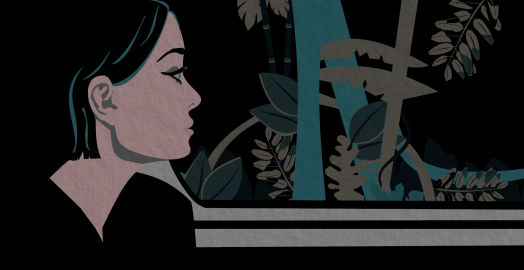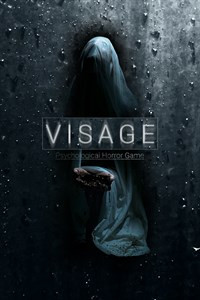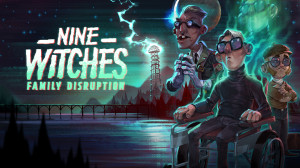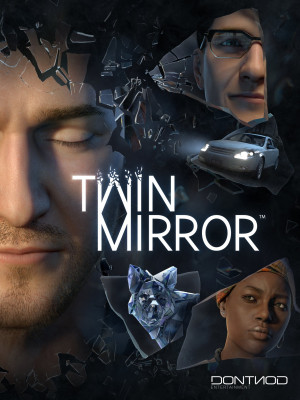Review for Sarawak

Adventure game enthusiasts are surely aware that the genre developed from text-based creations in the mid-1970s, graphics being a somewhat later innovation. Those early technological developments shared an interesting parallel in the print world with Bantam Books’ Choose Your Own Adventure series. Cowleyfornia Studios’ Sarawak, described by its designers as a “literary mystery game,” is in many ways more Choose Your Own than Colossal Cave Adventure, but it deserves a seat amongst modern works that continue the traditions of interactive fiction. It suffers some from a limited and inconsistent use of music, a sparsity of gameplay, and most seriously from a weak choice mechanism, but it also features a strong narrative and an inspiring interface with stylish design features and beautiful art. A short game, Sarawak should be a perfectly pleasant experience for those who approach it without the expectation of it being more than what it intends to be.
Sarawak starts off not in its titular setting, but rather in Oxford, England. You play as Mia Green, a young undergraduate student on vacation with her mother, an anthropology professor. When another professor is murdered nearby, Mia is shocked to find that her mother has been detained as a suspect. Eager to uncover the truth beneath this mysterious occurrence, Mia attempts to learn more about the victim, and in doing so discovers that not only did he have a special relationship to her, but also that he set up an elaborate scavenger hunt in the event that he was unable to contact her before his death. Following the trail will lead Mia to Sarawak, the Malaysian state of the Borneo Islands, where she will learn disturbing secrets that connect the professor’s past with her life and upbringing—complicating her relationship with her mother in the process.
Sarawak’s presentation falls somewhere in between a picture book and graphic novel, with conversation depicted through speech balloons and the main prose complemented by illustrations. The primary player tasks are reading and selecting between a few different options presented. For example, at the beginning of the game you are approached by Detective Constable Morgan, who tells you the police have reason to believe your mother was the last person in contact with the professor before he was murdered. DC Morgan would thus like to ask you some questions. You can choose between immediately cooperating, requesting to use the restroom first as an excuse to phone your mother, or asking the detective if you need a lawyer.
The game is divided into ten chapters—the first half taking place in Oxford, the second in Sarawak, with a brief epilogue completing the story. Each chapter title is visible from the start in the game’s menu, but initially you can only play the first. As you finish each section, you gain access to the next, and the parts that have already been completed can be replayed at any point. Since the chapters are self-contained units accessed independently of one another, the choices you make within one chapter do not affect the content in later ones.
While the choices made within a particular chapter could conceivably create paths that diverge substantially as long they arrive to more or less the same ending, in Sarawak they have little influence over the structure. This means there is not really much room for your decisions to have any meaningful or serious impact. However, you are able to make small choices throughout that influence the color or mood of a particular scene in minor ways. For instance, ask for coffee at a restaurant and a pot of coffee will appear on your table; ask for tea and you’ll get tea. Or you could say you don’t want anything, and … you guessed it! You get nothing.
Along with affecting the flavor of a given situation, you often get to select your investigative strategy. Do you pretend to be someone else to gain access to a restricted area, or are you honest about your intentions? Do you directly interact with a suspicious person, or do you observe them quietly from afar? While this is an approach with intriguing possibilities, these situations resolve more or less immediately, often through a deus ex machina sort of intervention, undercutting the potential weight of conflict in having to choose.
Indeed, the only real emotional decisions in Sarawak are the ones Mia must make with regard to her mother. Since the central mystery reveals details that complicate this relationship, at times you are presented with options that determine Mia’s general attitude and how she is processing what she is discovering—much of which concerns her mother. These moments provide small opportunities for meaningful conflict, but they likewise pass very quickly and have no impact on the overall story. There is one final judgment of serious narrative consequence that comes at the very end, in the epilogue, but what follows feels like a letdown anyway, regardless of what you decide.
Perhaps the most significant way your decisions become consequential is that certain options may get you to your goal a little bit more quickly while others will lead you into tiny tangents before you arrive at the same point. These deviations are easy to avoid, with clear indications that they’ll take you further from your goal, but the skipped narrative material often contains fun or humorous little bits of content you’ll miss out on by choosing the more efficient routes.
That Sarawak lacks a choice mechanism with meaningful repercussions is maybe not a flaw per se, but it’s hard not to see it as a missed opportunity given that reading and selecting between various prompts is what you will spend the most time doing by far. Moreover, the availability of different paths leading to distinct outcomes would have greatly increased replay value—as it stands, the most there is to be gained by multiple passes is experiencing slightly different (and slightly more or less) narrative content leading to the same ultimate result.
The limitation of choice means that the story has to stand on its own without the additional enrichment of seeing how branching paths play out. The good news is that there is a compelling mystery at the heart of Sarawak that is both poignant and genuinely suspenseful. After the professor’s trail leads her to Borneo, Mia seeks to learn more about her connection with him, as well as to clear her mother’s name. Tracing the clues to locations such as the headquarters of a newspaper, a prison, and a government building, she discovers that her mother has misrepresented or omitted important details about her past, including undisclosed relationships and a legal issue carrying tragic repercussions. In good mystery novel fashion, one answered question leads to another being asked, with continually escalated stakes.
The writing and characters are believable, if not always presented with the depth and expert narrative pacing to be found in a great book. There is something of a surface-level quality to much of Sarawak, and a lot of the side characters such as Detective Constable Morgan feel rushed and contrived, having little identity outside of a few idiosyncrasies. But Mia is an interesting, likable protagonist who is smart and resourceful, and the psychological stress she faces in grappling with a bleak situation and the disheartening revelations she uncovers feels real. Furthermore, her mother and the professor, though largely absent from the immediate action, are highly effective as figures of importance to Mia. Ultimately, it is this web of relationships that makes the game’s story emotionally impactful.
Supporting all the reading are a number of fun tasks and puzzles. These are fairly varied, and usually low-key. At one point you finish solving a crossword puzzle to coax another character into letting their guard down; at another you piece together a strange message that has been ripped to shreds. One part that I found rather interesting requires using good research practice when looking through an archive. Granted, it simplifies the process so that you aren’t digging through hundreds of articles before advancing the story, but that it genuinely makes use of real-world principles of research, however slight—and more importantly, that it makes such an undertaking entertaining—is commendable and unique.
Such activities are enjoyable, but not because they are especially challenging—a few of them will give you a slight test of your abilities and not much more. What makes them engaging is how perfectly they are integrated into the game’s interface. Sarawak accomplishes something truly exceptional in the way it blends its text-based core with its illustrated environments, and interacting with both is truly a delight. An approach that is as intuitive as it is unique, along with exemplary art that is bold and stylish, makes for an endeavor that feels satisfying and more than compensates for whatever weaknesses Sarawak possesses.
The game starts with a grand landscape: an elegant building in the foreground, the spires of Oxford tapering off in the distance. Silhouettes of birds glide across the otherwise static image, drifting beneath a chapter heading perched gracefully in the sky. In the bottom right, the professor’s dead body is visible, and as you scroll down to begin the chapter, your viewpoint closes in on him until he rests at the top part of the screen. The Oxford chapters all open with this same establishing shot, but presented in different colors and zooming in on various parts of the city. The Sarawak sections opt for a darker but more dynamic heading—a profile image of Mia riding on a train, our perspective remaining with her as the landscape of Borneo careens past her in the background.
These beautiful headings will linger indefinitely until you use the mouse to scroll down –or you can click an arrow in the bottom right corner, which accomplishes the same thing. On the PC version I played, the mouse was the sole means of control, making this a purely point-and-click affair, if not in the traditional sense. As you scroll down, you will encounter a variety of illustrations bringing the narrative to life. Some of these are interactive in important ways necessary to engage with in order to advance, while others are in small ways that do little to progress the narrative but add an incredible amount to immerse you into it.
Whether big or small, these moments when you can interact with the illustrations are something special. A surprising amount of satisfaction can be gained from simply realizing that you can, say, flip a light switch on and off, the ostensibly static illustration transforming with the click of a mouse. One of my favorite parts of the game involves a large door with a chaotic arrangement of gears whose movability is not immediately apparent. Part of the pleasure of interactive elements like these comes from how smoothly and seamlessly the developers manage to unify it with the accompanying text. But discovering interactivity where it is not obvious is also one of the main ways Sarawak delivers excitement by catching you with something unexpected.
In addition to serving as a perfect complement to the prose, the artwork itself is expressive and detailed—vibrant and boldly stylized. The sometimes grisly subject matter is handled tastefully and offset by a light-hearted aesthetic. While the style is unique unto itself, at times the illustrations reminded me of old comic book art by creators such as Steve Ditko and Jack Kirby. The images often manage to achieve a layered look, creating the perception of depth in 2D, and at times some element of the interface is allowed to pass over an illustration in a way that evokes cardboard cut-out craftwork. The visual quality is consistently lovely, and in combination with the creative and flawlessly designed interface integration, it ensures the experience is always a pleasing one to look at.
Unfortunately, the same praise cannot be transferred to the sound and music. In stark contrast to the care and effort that was obviously put into the graphic design, there seems to have been almost a conscious decision not to worry all that much about sound. In fact, there is relatively little audio at all. This in and of itself is not a bad thing—the sense of quiet contributes heavily to the literary feeling the developers were after, and a sparse soundtrack lends an eerie atmosphere of tension appropriate to the mystery. After a while, the stillness becomes immersive and hypnotizing in much the same way as settling into a good book, so much so that straightforward sounds like a lock clicking disrupt the silence in a manner that is genuinely startling.
What is harder to overlook are the inconsistent and at times awkward ways music is utilized throughout. Much like sound effects, music is rarely to be heard in Sarawak, and there is no clear thematic or even aesthetic vision unifying it when it does make an appearance. The title screen features an original track—a lively number with a folksy melody and a dense, layered arrangement of virtual instruments, many of which vaguely evoke a jungle setting. This contrasts with another original work, in which obvious MIDI recordings stand in for what is described in the text as “two guitarists […] channelling their inner Django Reinhardt despite the absence of an audience.” A better, more notable moment involves an old recording of Gershwin’s “Rhapsody in Blue” played on a phonograph. While it’s interesting that a lot of the music emerges from within the world of the game, the inconsistencies in quality and utilization of selections makes for a score that feels like an underdeveloped afterthought.
Ultimately, even with its room left for improvement, Sarawak succeeds in the most important task of all: creating an experience that is fun, engaging, and memorable. Contrary to the inherent suspense and the gruesome way it opens, there is a comforting “readerly” feel at work—the cozy satisfaction of settling into a good book. While a better choice mechanism could have added so much more replay value to the experience, and a little more attention could have been paid to its sound design, the graphics, strong narrative, and creative interface combine to allow Sarawak to stand out from the crowd as a solid mystery adventure with a uniquely literary feel. I’m looking forward to seeing what Cowleyfornia Studios does next.
Our Verdict:
While certain areas of Sarawak are more developed than others, the end result is a well-crafted, beautiful mystery adventure with a uniquely literary feel that’s cleverly enhanced by an inspired interface.
































